|
Cover
Story
The
Artist of
People's Struggle
Mustafa
Zaman
 Zainul
Abedin is the name eternally tied up with the unforgettable
Famine Sketches, and with images of humans toiling to move
a bull-cart stuck in the mud, which he titled "Struggle".
But it was also paintings like "Monpura" -- the
mural-like 96 cm-long scrawl that encapsulated the aftermath
of the cyclone of 1970, and that image of "Rebellion"
depicting a raging bull, as well as many other images of boats,
women and Santal life that makes him undoubtedly the "pioneer"
in art in the true sense of the word. Many claim that he left
behind few masterpieces. Most of his detractors insist that
the Famine Sketches are the only significant bulk of work
that Zainul ever produced. All things said and done, the name
Zainul Abedin still retains the vitality and verve that existed
during the artist's lifetime. The legend lingers on; the genius
whose fame had once splashed across the Indian subcontinent
and made the artist stand out among his peers, is beaming
up all the signs of his luminosity to today's viewers through
his magnificent works. Zainul
Abedin is the name eternally tied up with the unforgettable
Famine Sketches, and with images of humans toiling to move
a bull-cart stuck in the mud, which he titled "Struggle".
But it was also paintings like "Monpura" -- the
mural-like 96 cm-long scrawl that encapsulated the aftermath
of the cyclone of 1970, and that image of "Rebellion"
depicting a raging bull, as well as many other images of boats,
women and Santal life that makes him undoubtedly the "pioneer"
in art in the true sense of the word. Many claim that he left
behind few masterpieces. Most of his detractors insist that
the Famine Sketches are the only significant bulk of work
that Zainul ever produced. All things said and done, the name
Zainul Abedin still retains the vitality and verve that existed
during the artist's lifetime. The legend lingers on; the genius
whose fame had once splashed across the Indian subcontinent
and made the artist stand out among his peers, is beaming
up all the signs of his luminosity to today's viewers through
his magnificent works.
Back in his early years in Kolkata (then Calcutta)
his supreme artistic abilities immortalised him and placed
him at the apex of the brewing art movements. But what really
made him out of the ordinary among a myriad of other talented
young artists? Each had an ingenious way of representing the
reality that they were a part of. Some, like the already famous
art gurus, Nandalal Basu or Jamini Roy, had an inclination
to draw on the tradition, but Zainul had an empathy for the
masses that had rarely been expressed in the visual arts,
let alone used to make bold artistic statements.
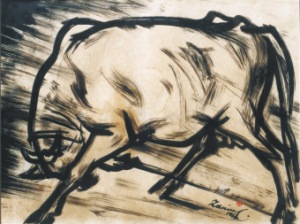 In
the European art scene, Daumier, Goya and Hogarth's efforts
predate Zainul's forays into the sufferings of people. However,
noone had articulated the passion for the masses with the
disarming simplicity that Zainul brought into play in his
famine sketches. And the dignity of the toiling men, too,
had never been expressed in a language that would leave such
a lasting impression in the collective psyche, as did Zainul's
paintings. Perhaps he is the only artist whose work has been
reproduced by self-taught denizens strewn across the country.
The acclamation that he received certainly broke boundaries
of class; his "Struggle" even ended up being on
the back of scooters and rickshaws. No 'high-art' exponent
had this luck. Many may not even look at it as such. But,
Zainul obviously did belong to the ilk that professed to have
put their ingenuity to the task of making images that had
socio-political as well as artistic relevance. His was an
aesthetic sense that was inclusionary. In fact, when he came
to Dhaka after the partition of India to establish an art
institution, he led a number of artists to galvanise an art
scene that doted on the reality of the then East Bengal, the
eastern province of newly independent Pakistan. He fertilised
the ground by practising and professing a mode of art that
never severed its link with the "people of the soil"
to set a precedent for the younger generation artists. In
the European art scene, Daumier, Goya and Hogarth's efforts
predate Zainul's forays into the sufferings of people. However,
noone had articulated the passion for the masses with the
disarming simplicity that Zainul brought into play in his
famine sketches. And the dignity of the toiling men, too,
had never been expressed in a language that would leave such
a lasting impression in the collective psyche, as did Zainul's
paintings. Perhaps he is the only artist whose work has been
reproduced by self-taught denizens strewn across the country.
The acclamation that he received certainly broke boundaries
of class; his "Struggle" even ended up being on
the back of scooters and rickshaws. No 'high-art' exponent
had this luck. Many may not even look at it as such. But,
Zainul obviously did belong to the ilk that professed to have
put their ingenuity to the task of making images that had
socio-political as well as artistic relevance. His was an
aesthetic sense that was inclusionary. In fact, when he came
to Dhaka after the partition of India to establish an art
institution, he led a number of artists to galvanise an art
scene that doted on the reality of the then East Bengal, the
eastern province of newly independent Pakistan. He fertilised
the ground by practising and professing a mode of art that
never severed its link with the "people of the soil"
to set a precedent for the younger generation artists.
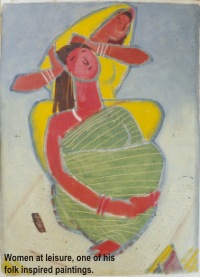 Murtaja
Baseer, a prominent artist who was a student of Zainul, says,
"One can easily draw a comparison between Zainul and
Jasimuddin. Both are recognised at the drop of their names
all around Bangladesh. Zainul too felt a strong affinity towards
the rural masses." In return, he was loved back, and
18 years after his death, in the year of his 90th birthday,
he still remains the most recognised and revered artist of
his land. Murtaja
Baseer, a prominent artist who was a student of Zainul, says,
"One can easily draw a comparison between Zainul and
Jasimuddin. Both are recognised at the drop of their names
all around Bangladesh. Zainul too felt a strong affinity towards
the rural masses." In return, he was loved back, and
18 years after his death, in the year of his 90th birthday,
he still remains the most recognised and revered artist of
his land.
"During the famine of 1943, Zainul suddenly
discovered that the peasants, the fishermen and women that
he identified with were rotting in the pavements of Kolkatta.
He was horrified that they came to the city to die,"
Baseer throws light on the working of the maestro's mind.
What Zainul did was not mere documentation
of the famine. I the sketches the signs of famine manifested
in all its sinister attributions through the emaciated and
skeletal figures of a population fated to die of starvation
in a man-made plight. Zainul depicted the inhuman saga with
an intense human passion only possible for a great mind.
As the drawings of the famine-struck men,
children and women remains a cornerstone in the history of
art in this region, they helped shape an artist's path. Zainul's
conviction kept him forever in sympathy with the poor. Zainul
may have rendered damsels in leisure; doing their coiffure,
or while bathing in the river, but his idiom was distinctly
laden with a strong sense of reality. His gaze was never 'disinterested'
or 'abstract.' Beauty he sought, beauty he achieved in many
of his paintings without sacrificing the struggle that is
associated with the lives he depicted.
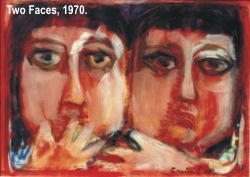 Abul
Monsur, a noted art critic, writes, "If one considers
the rural people's life and what they have created as a whole
in the form of the very fabric of their lives' saga -- one
will realise the originality and the appeal of Zainul's creativity."
The notion of an artist internalising the human experiences
by remaining at a human level was unique, and Zainul remains
the pioneer by forging this marriage between life and art. Abul
Monsur, a noted art critic, writes, "If one considers
the rural people's life and what they have created as a whole
in the form of the very fabric of their lives' saga -- one
will realise the originality and the appeal of Zainul's creativity."
The notion of an artist internalising the human experiences
by remaining at a human level was unique, and Zainul remains
the pioneer by forging this marriage between life and art.
His death on May 28 in 1975, was sudden. Although
he was suffering from cancer of the lungs since December of
the previous year, the time when the disease was detected
after he fell ill and was flown to London for treatment, Zainul's
death at the age of 62 caught many by surprise. The outpouring
of grief on the day he died was unprecedented.
 Since
his death, little has been done to advance his aesthetic goal.
With the leading man absent, his works too remained hidden
from the public gaze. Except for the January show of 1977
at the Shilpakala Academy that coincided with the publication
of a book on the master by Nazrul Islam, an art writer, the
sightings of his real works have been sparse. In a handful
of group shows and in the regular display at the National
Museum his admirers had the chance to look at some select
paintings. Since
his death, little has been done to advance his aesthetic goal.
With the leading man absent, his works too remained hidden
from the public gaze. Except for the January show of 1977
at the Shilpakala Academy that coincided with the publication
of a book on the master by Nazrul Islam, an art writer, the
sightings of his real works have been sparse. In a handful
of group shows and in the regular display at the National
Museum his admirers had the chance to look at some select
paintings.
The current giant of a show organised by the
consortia of Bengal Foundation, Bangladesh Shilpakala Academy
and the Bangladesh National Museum has put an end to that
situation. With the help of Zainul's widow, Jahanara Abedin,
these three organisations have pulled off, at last, a retrospective
of the master artist of Bangladesh. This is a landmark in
the history of curating; no retrospective show of this proportion
has ever been envisaged before.
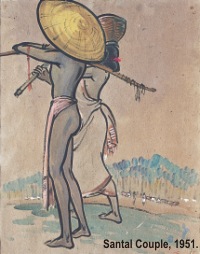 "Our
intention was to re-introduce Zainul through his works--the
pieces many might've seen in reproduction but never in original
form. His big paintings like Nobanya or Monpura succinctly
tell of his artistic might," exclaims Subir Chowdhury,
the former Director of the Department of Fine Arts at the
Shilpakala Academy who now remains at the helm of Bengal Gallery
as its director. "Our
intention was to re-introduce Zainul through his works--the
pieces many might've seen in reproduction but never in original
form. His big paintings like Nobanya or Monpura succinctly
tell of his artistic might," exclaims Subir Chowdhury,
the former Director of the Department of Fine Arts at the
Shilpakala Academy who now remains at the helm of Bengal Gallery
as its director.
Dispersed in three different venues, the show
of 573 original works has been launched simultaneously at
the National Gallery of Bangladesh Shilpakala Academy, at
the National Museum and Bengal Gallery of Fine Arts on December
12. There are side-shows and events that centre around this
main exhibition that will last till January 7, 2005.
Zainul is the first artist to have been given
such an honour at the 'national level.' "For many years
people have been unhappy about the fact that there has been
no effort to showcase Zainul's works. The dominant tone was
that there has been effort at the national level for Abbas
Uddin, the legendary singer, but the man we call the 'father'
in the field of fine arts has never been a subject of a full-blown
solo show," notes Subir Chowdhury.
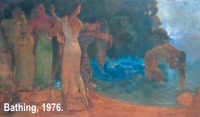 However,
while in the hot seat of the Shilpakala Academy, Chowdhury
and his colleagues toyed with the idea of having a grand retrospective
of the maestro. In fact, Shiplakala Academy did arrange for
the first solo after Zainul's demise. On January 1977, a show
of his works in the former national gallery was the first
tribute at a national level. "The book that was published
on the occasion was the first major publication on Zainul.
And it was planned and executed at very short notice,"
remembers Chowdhury who joined the Academy in 1975. However,
while in the hot seat of the Shilpakala Academy, Chowdhury
and his colleagues toyed with the idea of having a grand retrospective
of the maestro. In fact, Shiplakala Academy did arrange for
the first solo after Zainul's demise. On January 1977, a show
of his works in the former national gallery was the first
tribute at a national level. "The book that was published
on the occasion was the first major publication on Zainul.
And it was planned and executed at very short notice,"
remembers Chowdhury who joined the Academy in 1975.
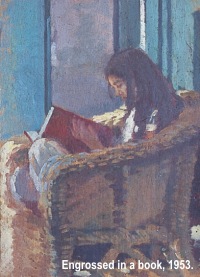 For
the present show, a lot of brain-storming as well as time
have been invested. "Planning started as early as last
May. I was still with the Shilpakala Academy and on July 7th
a formal meeting among the three organisations were arranged.
The family of Zainul Abedin was also there. It was Jahanara
Abedin, who played a pivotal role and it was the Bengal Gallery
that was ready to pay the bills," explains Chowdhury. For
the present show, a lot of brain-storming as well as time
have been invested. "Planning started as early as last
May. I was still with the Shilpakala Academy and on July 7th
a formal meeting among the three organisations were arranged.
The family of Zainul Abedin was also there. It was Jahanara
Abedin, who played a pivotal role and it was the Bengal Gallery
that was ready to pay the bills," explains Chowdhury.
To give the event national significance, assistance
was sought from the government of Bangladesh. "On August
14th we met with the Cultural Minister, who gave us the green
light," Chowdhury notes. He then goes on to reflect on
the maestro's artistic proclivities. He says, "He had
immense interest in craft and the craft people of Bangladesh.
In fact, he had this idea of a fine art that was already stilted
on the traditional practices of the land that is kept alive
in our craft. To pay homage to his love for craft we have
arranged for a 'Karumela' (craft fair) that strives to show
the present state of craft."
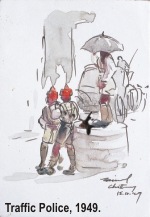 Crafts
were significant to him, they even moulded some of his stylistically
rigorous paintings. During the mid 50s he tried his hands
at folk-art motifs-derived images. In an interview with Nazrul
Islam, Zainul once vented his dissatisfaction over a string
of the first and second batch students being caught in the
trap of 'modern trends' that defied any link with the cultural
brio that characterises the land and people. Crafts
were significant to him, they even moulded some of his stylistically
rigorous paintings. During the mid 50s he tried his hands
at folk-art motifs-derived images. In an interview with Nazrul
Islam, Zainul once vented his dissatisfaction over a string
of the first and second batch students being caught in the
trap of 'modern trends' that defied any link with the cultural
brio that characterises the land and people.
The man who was known for his art and compassion
for his people, lived a simple life. Born in a humble abode
of a "minor police official" he had an even humbler
upbringing. Though his grand father, a petty trader, lived
in Mymensingh, Zainul was born in Kishoreganj, where his father
was posted at the time.
His mother Jainabunnessa came from a family
that "hadn't yet welcomed modern education," writes
Syed Azizul Haque in the preface of the catalogue that has
been put out on the occasion of the retrospective show.
 The
periodic transfer of his father from one place to the other
exposed young Zainul to mofussil towns of Mymensingh
and to its rural rustic life. His peripatetic father, Sheikh
Tamizuddin Ahmed settled in Mymensingh town proper in 1926.
He built a small house for the family. It was in Mymensingh
that the cultural firmament finally brushed on to young Zainul. The
periodic transfer of his father from one place to the other
exposed young Zainul to mofussil towns of Mymensingh
and to its rural rustic life. His peripatetic father, Sheikh
Tamizuddin Ahmed settled in Mymensingh town proper in 1926.
He built a small house for the family. It was in Mymensingh
that the cultural firmament finally brushed on to young Zainul.
As a high-school student, he developed the
knack for drawing and painting; it almost came naturally to
him. Rote learning could never interest him. In Mymensingh
he found his peers among a few 'like-minded friends, among
them Ashish Ghatak (1914-1974), brother of the celebrated
film-maker Ritwik Ghatak (1925-1976), and Premranjan Dasgupta,
owner of a photographic studio which was a meeting ground
for Mymensingh's artistically inclined youth," writes
Haque.
 In
1932, upon completion of high school, young Zainul left for
Art College in Kolkata. He took the admission test at the
then Calcutta Art College in 1932, and topped the merit list.
It was Mukul Dey, an eminent artist and the principal of the
college, who recommended Zainul for the "District Board
stipend," which was duly awarded to him. Soon, the budding
young artist made a name for himself for his studiousness;
he devoted much of his time in drawing and painting. In
1932, upon completion of high school, young Zainul left for
Art College in Kolkata. He took the admission test at the
then Calcutta Art College in 1932, and topped the merit list.
It was Mukul Dey, an eminent artist and the principal of the
college, who recommended Zainul for the "District Board
stipend," which was duly awarded to him. Soon, the budding
young artist made a name for himself for his studiousness;
he devoted much of his time in drawing and painting.
Zainul as a student lived in a boardinghouse
to cut down on expenses. It was during his advanced years
when he started contributing cartoons and illustrations to
newspapers to earn money that helped pay his own bills and
to send some to cover the expense of his younger siblings.
Later he moved into a flat, probably the one that Jahanara
Abedin remembers as the first home to the newly wed couple
in Kolkata.
"At
the Tarok Dutta Road house he used to cook, as I told him
earlier that I had no expertise in that area," recalls
Jahanara Abedin.
 They
got married in October 1946. "It was Shafiqul Amin, the
elder brother of my sister's husband, who was the matchmaker.
We came to know that 'Zainul was a good man and what others
couldn't draw using paint and ink he could using ashes of
cigarettes," notes Jahanara. They
got married in October 1946. "It was Shafiqul Amin, the
elder brother of my sister's husband, who was the matchmaker.
We came to know that 'Zainul was a good man and what others
couldn't draw using paint and ink he could using ashes of
cigarettes," notes Jahanara.
Zainul started teaching even before graduation.
He started teaching at the college when he was in the fifth-year.
In the following year he got the Gold Medal in an all-India
Art Exhibition organised by the Academy of Fine Arts.
Before
this, he had to make an important decision in his life. He
was in the third year and it was time to choose his area of
specialisation. Mukul Dey, his mentor, wanted him to pursue
"Oriental Art", but Zainul thought it was important
for him to learn the Western academic technique than to restrict
himself in a stylistic ardour, namely oriental art that draws
on Moghul and Rajput paintings.
Zainul's intention was to capture the lives
and rhythm of the reality that he was a part of, and the best
way to capture that was to learn realism. Studying painting
served this cause.
Robust
talent and goodness came together to make up the character
that Zainul was. During her first sojourn to Kolkata Jahanara
Abedin had the opportunity to meet Jamini Roy, the famous
painter, who came up to her and announced, "From where
did he find this poter putul (iconic doll)"
and then added referring to Zainul, "Take care of this
precious gem, or else there will be a great loss
Before
the Second World War, Zainul was awarded the three-year British
Government scholarship in the UK, but the war prevented him
from taking it up. By then his temporary appointment as a
teacher was made permanent when the untimely death of Abul
Moin, the first Muslim teacher of the college, created a vacancy.
 In
1943, the Bengal Famine put Zainul in the role of an artist
who had little energy to live in the aesthetised world of
beauty and grace. What he produced in a series of brush and
ink drawing was to become the most memorable images of human
suffering. In
1943, the Bengal Famine put Zainul in the role of an artist
who had little energy to live in the aesthetised world of
beauty and grace. What he produced in a series of brush and
ink drawing was to become the most memorable images of human
suffering.
"The Chinese ink that he used to use
made the brushes hard, and Zainul used to smash them with
a brick to soften them," Murtaja Baseer recalls his teacher's
foray into making do with whatever was available. Baseer believes
that the distinct "hard-brush-technique" resulted
from the manhandled brushes. "And he later deliberately
put that into use."
After marriage came the partition of India.
Zainul moved to Dhaka with his wife and became a teacher at
the Dhaka Teachers' Training School.
"Dhaka
had limited lodging facilities and we had to settle for my
mother's house at Johnson Road. This is how our life in Dhaka
began," remembers Jahanara Abedin. "He was constantly
disturbed, as his job did not suit him. And he had to do all
those works to make money -- from painting book covers to
the labels on oil containers," Jahanara explains.
Then he went off to Karachi where he was gainfully
employed as a designer in the government Publishing Department.
"The salary was more than six hundred rupees; but he
was not content, as his mind was set on establishing an art
college," Jahanara recalls.
In March 1949 he took up the position of the
principal of the art institute in Dhaka, one that started
off using a couple of rooms of the then National Medical School.
There was an outcry from the religious bigots, but Zainul
was undaunted. A resolute man, he soon started lobbying the
government for separate premises that would house the first
full-fledged art institute of the then East Pakistan. His
dream came to fruition in 1952, and a two-story house at Segun
Bagicha was alloted to the institute. Zainul could only turn
it into a college in 1963, the year the authorities agreed
to convert it into the Government College of Arts and Crafts,
which for the first time offered the Bachelor of Fine Arts
degree.
As a teacher Zainul was a dedicated soul.
Baseer, who entered the Government Institute of Arts in 1949
remembers how his teacher emphasised the practice of "drawing".
There were two ways he planned to strengthen the wrist of
a novice. One was to copy in a sketchbook the format of hand,
leg and face that Nandalal Bose put forward; and the other
was to do the same on a blackboard. It helped a lot for any
striving artist to gain control over lines and its rhythm,"
notes Baseer.
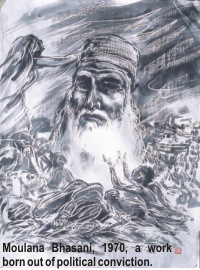 He
also remembers the day his revered teacher visited his home
to "have a look at the paintings." "The day
was March 22, 1955. I even kept his autograph signed on the
day," recalls Baseer. "He was as usual full of praise.
With a particular piece on a brown cardboard, I took caution,
I said, 'this is unfinished as I haven't covered a part with
paint,' but he was judicious in his verdict and he said, 'It
is finished and an excellent effort.' A good painter knows
when to stop putting on colours, he taught us that,"
Baseer testifies. He
also remembers the day his revered teacher visited his home
to "have a look at the paintings." "The day
was March 22, 1955. I even kept his autograph signed on the
day," recalls Baseer. "He was as usual full of praise.
With a particular piece on a brown cardboard, I took caution,
I said, 'this is unfinished as I haven't covered a part with
paint,' but he was judicious in his verdict and he said, 'It
is finished and an excellent effort.' A good painter knows
when to stop putting on colours, he taught us that,"
Baseer testifies.
He had the most cordial relationship imaginable
with his students. When Baseer was in the second year, he
and his friends, Qayyum Chowdhury, Rashid Chowdhury and others
even pulled a nasty prank on their beloved teacher. They forged
the letter of the governor's wife, inviting Zainul to meet
her on the evening of April 1. "We on that day wanted
to fool our most revered teacher. We kept a watch on him after
sending him the false invitation. When in the afternoon he
took a rickshaw to meet Lady Viqarunnessa, a friend and I
followed and stopped him to tell him about our design. He
was not angry. The kind of relationship we had with him can
never be imagined today," Baseer contends.
As an artist he related to Baseer what can
be termed an eternal motto for life. Zainul said, "You
build yourself to be a person so that when somebody praises
you, you will smile and if somebody criticises you, you will
smile."
In 1967 Zainul took an early retirement from
the post of the principal at the Government College of Arts
and Crafts. "I became aware of the disturbances at the
college, but he never used to talk about it. After he left
college, the Chief Secretary came with his wife to visit to
coax him to go back. But, his answer was clear, he said, "I
couldn't do much, as I was engaged in establishing the college.
Now, I like to devote my time to my own work," Jahanara
remembers. It was at that point of his life that he created
many of his oil paintings. He had always preferred to use
watercolour or brush and ink for their immediacy, but now
he had time to delve into oil.
"He went off to Karachi to sell his works,"
recalls Jahanara. He did a stint as Honourary Advisor to television,
film and publications department of Pakistan from 1968 to
1970. This was the time he spent mostly is Karachi.
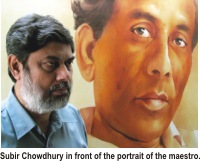 As
a pioneer painter of this region, he devoted a lot of time
in organising the artists to advance the cause of culture.
Perhaps the sojourns to UK, Japan, USA and many other countries
in the mid-fifties made him more aware of the heritage of
Bengal. He organised the first exhibition of folk art and
craft at the institute's campus. He even urged fellow artists
to look for inspiration in the folk heritage of the time. As
a pioneer painter of this region, he devoted a lot of time
in organising the artists to advance the cause of culture.
Perhaps the sojourns to UK, Japan, USA and many other countries
in the mid-fifties made him more aware of the heritage of
Bengal. He organised the first exhibition of folk art and
craft at the institute's campus. He even urged fellow artists
to look for inspiration in the folk heritage of the time.
His political visions too were as clear as
the artistic ones. During the last few years of the Pakistan
regime, when the movements for an independent Bangladesh gained
momentum, Zainul aligned himself with the political force
that wanted freedom and fought for an identity of their own
based on Bangali nationhood. At a mass rally called by Maulana
Bhashani in February 1971, he publicly renounced the civic
honours he had received from the Pakistan government. On March
12 of the same year, he led a procession of the "Artists'
Revolutionary Council ("Charu O Karu Sangram Parishad)
and at a congregation at Bahadur Shah Park declared that the
Bangalis had no alternative but to fight for independence.
An organiser of the Dhaka Group in the 50s,
Zainul, after Bangladesh came into being in 1971, became immersed
in responsibilities of national importance. He suffered a
mild stroke in 1972 that resulted in partial facial paralysis,
for which he went abroad to seek treatment. Upon his return
he was entrusted with the responsibility of preparing a calligraphic
copy of the country's new constitution. He was also appointed
as chairman of the Bangla Academy for two years. He also was
selected visiting Professor at Dhaka University. In 1974 he
was nominated member of the governing council of the newly
formed Bangladesh Shilpakala Academy. He became one of the
first three national professors the following year. 1975 also
saw the inauguration of the two institutions he had long dreamt
of setting up -- the Sonargaon Folk Art Museum and the Zainul
Museum in Mymensingh.
The present show has created an opportunity
for the art lovers to discover the maestro by scrutinising
his real works. The Bengal Foundation wanted to turn the occasion
into a celebration of Zainul and his work.
At a seminar on December 24, where Abul Monsur
presented a paper and was attended by Ganesh Halui from India,
and Jalaluddin Ahmed from Pakistan. Ahmed wrote a book in
1958, the first major publication on Zainul.
The Foundation wants to instil in the young
generation the spirit that guided Zainul. "We arranged
for two buses sponsored by Grameen Phone to bring the school
children to the venues of the show. It started from December
14," reflects Subir Chowdhury who is not all too satisfied
to see the lack of attention this mega show has attracted.
"I have seen long queues in front of
museums abroad to see art shows. I feel there must be more
effort on our part to augment the interest of people on art,"
Chowdhury continues.
The novel attempt also has its detractor,
who accuses the organisers of displaying a forgery or two
in the retrospective show. Subir Chowdhury has a clear answer
to that, "There was a selection committee where eminent
artist like Kibria and Qayyum Chowdhury as well as Jahanara
Abedin were part of. They chose the entries. We honoured their
decision."
However, there are paintings that still remain
missing from the public domain. The oil works in Pakistan
had never been traced. And Jahanara Abedin gives more examples
of paintings that disappeared. "There was a visit to
Palestinian camps at Syria and Jordan in 1970. He worked on
60 to 70 paintings there. He was to have a show in Egypt but
by then the war broke out and the pictures were lost forever,"
laments Jahanara.
She also says that the paintings that are
kept in the Zainul Museum in Mymensingh are ill maintained.
"I asked my husband not to donate such beautiful and
important works to the museum when it was just being set up.
He was adamant he shared the sprit of Sheikh Mujib 'of building
everything from the root-level,'" exclaims Jahanara.
"Even the huge collection of the National
Museum is in need of a permanent space, as only a small portion
can currently be shown in their regular display," says
Jahanara. Her contention is clear: she wants the works of
the maestro who is the Shilpacharya (the Master of Arts) --
to be given the proper treatment by making sure that his original
works are preserved properly to inspire and delight future
generations.
Copyright
(R) thedailystar.net 2004
|
